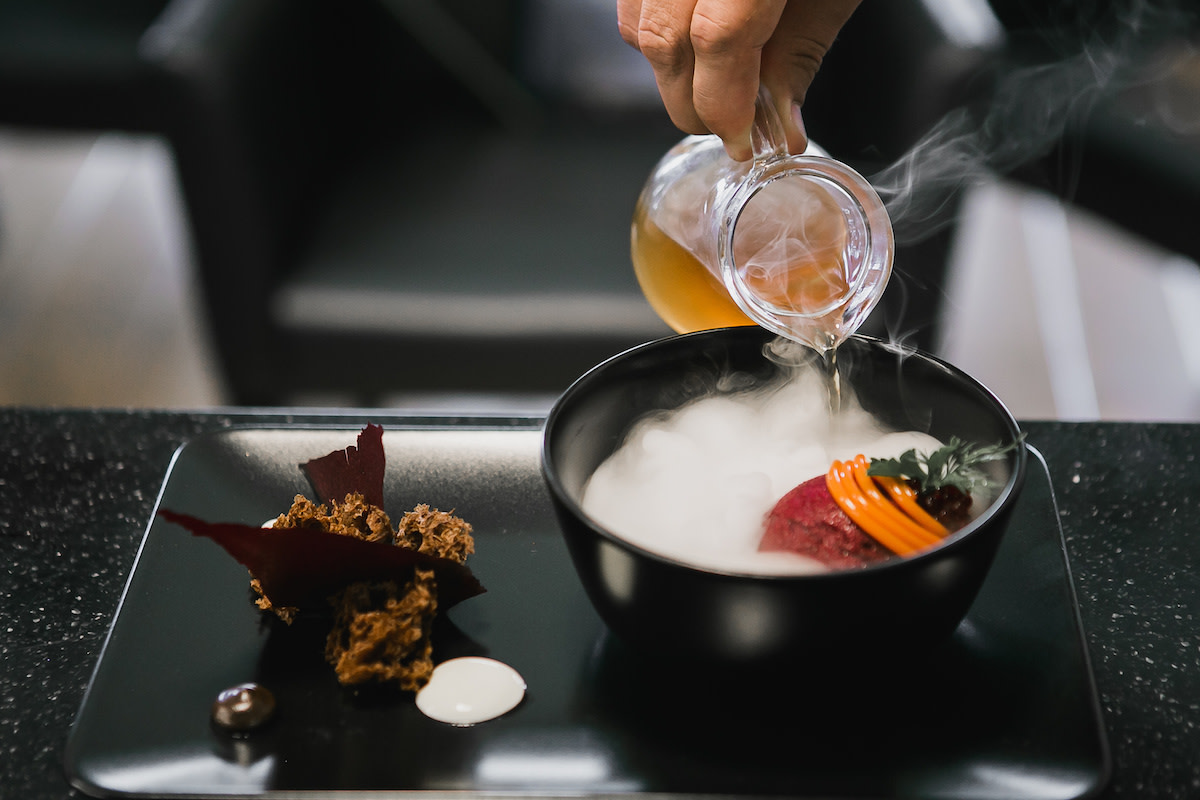A Guide to Molecular Gastronomy: 8 Molecular Gastronomy Methods
Written by MasterClass
Last updated: Aug 11, 2021 • 3 min read
Molecular gastronomy is a style of cooking that relies on chemistry to create unexpected dishes that push the boundaries of traditional food. Learn more about this culinary style that takes the science of cooking to new heights.
Learn From the Best
What Is Molecular Gastronomy?
Molecular gastronomy is a scientific discipline within the culinary arts that involves preparing food in a way that highlights the physical and chemical reactions between different food ingredients. This discipline of modernist cuisine encourages chefs to experiment with avant-garde flavor combinations and food presentation methods. Popular molecular gastronomy cooking techniques include the gelification of a purée or turning a liquid into foam.
Hungarian physicist Nicholas Kurti and French chemist Hervé This came up with the term ‘molecular and physical gastronomy’ in 1988, and just a few years later it was being taught in cooking workshops in Italy. Since then, modern cuisine restaurants focusing on molecular gastronomy have surfaced all over the world, with chefs constantly introducing innovative molecular cooking techniques.
8 Techniques in Molecular Gastronomy
Molecular gastronomy uses a number of food processing methods to achieve a desired flavor profile or chemical reaction. Some different techniques include:
- 1. Dehydrating: Dehydration removes all the moisture from foods such as fruits, vegetables, or meats, with a dehydrator in order to change their flavor and texture (while also extending their shelf lives). While dehydrating is a process that has been used for centuries as a way of preserving meat, molecular gastronomists use this method in creative culinary ways to highlight unique textures.
- 2. Spherification: Spherification refers to the process of adding sodium alginates—a type of polysaccharide/viscous gum derived from algae—to a liquid that transforms it into chewy orbs resembling caviar. The tapioca pearls in bubble tea (or boba) are an example of spherification used in food.
- 3. Foaming: Food foam is created when liquid is mixed with emulsifiers like soy lecithin, maltodextrin, carrageenan, or agar-agar, then placed in a canister with nitrous oxide. The gelling agent mixes with the gas, transforming the liquids into emulsions. The result is an aromatic or flavorful essence usually used as a sauce or a garnish for a dish.
- 4. Flash-freezing: Flash-freezing involves exposing food to liquid nitrogen or low temperatures just long enough to freeze the outside without solidifying its inside or creating ice crystals.
- 5. Carbonating: Adding carbon dioxide to make an ingredient effervescent is another popular molecular gastronomy. Carbonating ingredients like sugar can create air bubbles to add a popping sensation to sweets and desserts.
- 6. Sous vide: Sous vide cooking is a low-temperature cooking technique that involves vacuum sealing or compressing food before immersing it in a water bath that cooks the ingredients. Sous vide cooking helps trap in moisture and heat ingredients quickly, yielding extra tender dishes.
- 7. Thickening: Thickening liquids with polysaccharide thickening agents like guar gum or xanthan gum (or other modified starches) can improve their texture without exposing them to heat or additional aggressive cooking methods which can drastically change their flavor.
- 8. Glueing: Transglutaminase is an enzyme that can speed up protein reactions between substances so they adhere together. It is often used as an additive in foods such as meatballs, tofu, and yogurt.
6 Examples of Molecular Gastronomy
There are many different forms of molecular food preparation that can create an added layer of flavor dimension to meals. Here are a few examples of dishes that involve molecular gastronomy.
- 1. Soufflés: A soufflé involves molecular gastronomy since it relies on chemistry to change the forms of its ingredients. It requires the right mixture of egg whites and other ingredients whisked together and baked at just the right temperature to create an extra thick, yet light and aerated pancake.
- 2. Creme brulée: Creme brulee uses a small flame torch to heat the top layer of sugar until it crystallizes and forms a sweet, crunchy coating.
- 3. Foam foods: Chefs have been able to craft foams out of a wide array of ingredients, coming up with creations such as pineapple or even lobster foam.
- 4. Smoked cocktails: Burning wood like hickory or applewood and adding it to a cocktail is referred to as a ‘smoked cocktail.’ Adding smoke to beverages can give the overall flavor an added layer of dimension.
- 5. Salad dressing: Chefs specializing in molecular cuisine may turn balsamic vinegar and olive oil into pearls that you can add to salads in place of traditional liquid dressing.
- 6. Ice cream: When ice cream is freeze-dried, the ice crystals in the ice cream become vapor, transforming it into a form of dehydrated ice cream that is hard, and crumbles when you bite into it.
Want to Learn More About Cooking?
Become a better chef with the MasterClass Annual Membership. Gain access to exclusive video lessons taught by the world’s best, including Niki Nakayama, Gabriela Cámara, Chef Thomas Keller, Yotam Ottolenghi, Dominique Ansel, Gordon Ramsay, Alice Waters, and more.
